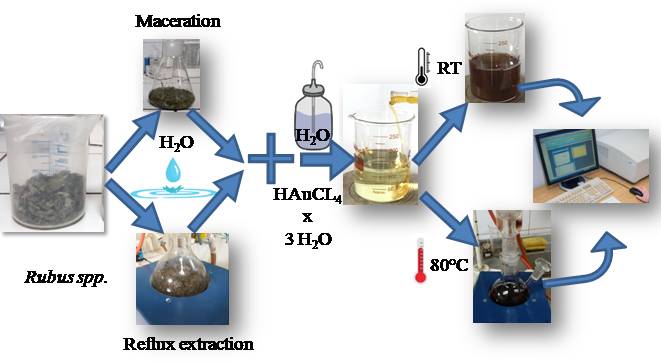
Synthesis, characterization and biological activity of gold nanoparticles stabilized by aqueous extracts of wild blackberry (Rubus spp.) leaves
Marija S. Tasić, Jelena B. Zvezdanović, Ljiljana P. Stanojević, Jelena S. Stanojević, Sanja M. Petrović, BojanaDanilović, Dragan J. Cvetković
Том 86 №5
338 просмотров;
The green synthesis of gold nanoparticles (AuNPs-E) by bioreduction of chloroauric acid (HAuCl4), using the aqueous extracts (E) of blackberry (Rubus spp.) leaves, was presented in this work. The E were obtained by maceration at room T and reflux extraction at boiling T, while the AuNPs-E were synthesized at room T and T=80°C. The synthesized AuNPs-E were structurally and physicochemically characterized by UV-Vis and FTIR spectroscopy, X-ray diffraction (XRD), scanning electron microscopy (SEM), energy dispersive X-ray (EDX) spectroscopy, dynamic light scattering (DLS) and zeta potential measuring. The changes in the FTIR spectra suggested that biocompounds containing C=O, C-O-C, and OH functional groups play the main role as capping and stabilizing agents providing the stability of AuNPs-E confirmed by UV-Vis spectroscopy. The crystal structure was proved by XRD analysis confirming the (111) reflection plane at 2θ = 38.2° as dominant in the AuNPs-E face-centered cubic lattice. Negative zeta potential of AuNPs-E in the range of -11.67±0.45 and -17.70±0.27 mV suggests moderate stability of AuNPs-E with the average size in the range of 61.6±11.5 to 93.9±1.4 nm determined by DLS. The qualitative and quantitative presence of Au in the formed AuNPs-E, together with the elements from the extracts’ biomolecules, was proven by the EDX spectroscopy. Finally, the antioxidant and antibacterial activities of AuNPs-E were tested by DPPH test and disc diffusion method, respectively, suggesting that AuNPs-E synthesized by described method should be certainly taken into consideration, alone or in combination with the silver nanoparticles, in dermal and cosmetic preparations design.